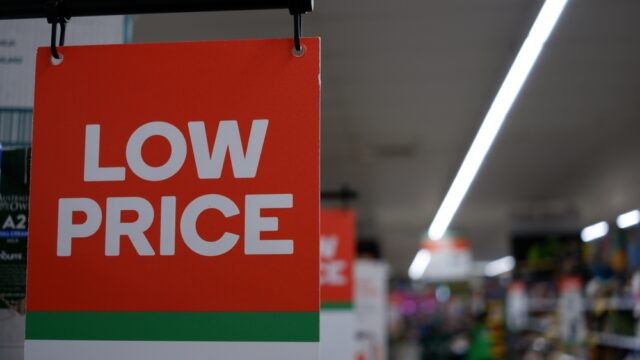
One of the most difficult brand positions to navigate is low price. When choosing this strategy, brands must be willing to take a loss in bad economic times and accept lower margins than their competition when business is good. There are lots of examples of brands that have made low prices a part of their brand strategy, some succeed while others don’t. So, how do these low-price stalwarts do it?
I am a 35+ year collector of vinyl records. While I listen to all kinds of music, the music from my youth, punk rock, still has a special place in my heart. During the late 70s and early 80s some bands started including the price of their records in the cover art. The UK band Crass famously included the statement “Pay No More Than £2.00” on the cover of their 1978 debut “The Feeding of the 5000.”

Photo credit: Radoslaw Maciejewski/Shutterstock.com
Meanwhile, across the pond, the Washington, DC band Minor Threat was growing in popularity. As a result, record stores began increasing the prices they charged for the band’s albums. This led to some fans accusing the band of “cashing in” on their success. Their label, Dischord Records, responded by including “$3.50 Postpaid From Dischord” on the cover of the 1983 repress of their “Out of Step” EP.
But what is interesting, and what I’m sure these bands never considered at the time was, what do we do 40 years from now when a £2.00 or $3.50 price for a release is less than half of our manufacturing cost?
When Crass reissued their catalog on CD in 2010, they dropped the original cover art altogether and replaced it with a puzzle. The cover of each of their albums was part of a larger image that collectors could assemble by purchasing the complete set.
When vinyl became popular again, Crass reissued their albums with all the original artwork. However, they charged the going rate for each release, drawing criticism of selling out from many of their longtime fans.
Dischord Records took a different approach. Over the years, they were forced to slowly raise their prices, and each time they updated the cover art of “Out of Step.” With each price increase, they communicated to their customers the reason for the increase and apologized for it. But the one thing they continued to do was make sure that their records were always $2-3 cheaper than the average price of other releases in the genre. Eventually, they remastered “Out of Step” and reissued it without the price on the front cover, which collectors really appreciated because that was the original artwork.

Photo credit: wisely/Shutterstock.com
To this day, on the back cover of every Dischord Records release, in the fine print, it still has the price that the consumer can pay to order the record directly from the label, $2-3 cheaper than the retail price.
Low-cost brands must carefully balance price and quality, regardless of economic conditions. Consumers do not tolerate when their expectations in these areas are violated. If you decide to take the low-cost route, craft a brand charter. Reread it at least once every day, and be creative and authentic in how you communicate the inevitable necessity of a price increase.
